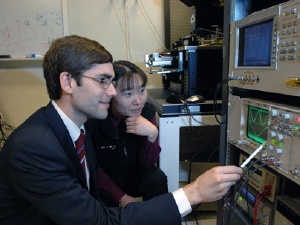Mar 19 2009
New research findings at MIT could lead to microchips that operate at much higher speeds than is possible with today's standard silicon chips, leading to cell phones and other communications systems that can transmit data much faster.
 EECS assistant professors Tomás Palacios, left, and Jing Kong examine oscilloscope traces showing the doubling in frequency of an electromagnetic signal processed through their experimental graphene microchip. Photo / Donna Coveney
EECS assistant professors Tomás Palacios, left, and Jing Kong examine oscilloscope traces showing the doubling in frequency of an electromagnetic signal processed through their experimental graphene microchip. Photo / Donna Coveney
The key to the superfast chips is the use of a material called graphene, a form of pure carbon that was first identified in 2004. Researchers at other institutions have already used the one-atom-thick layer of carbon atoms to make prototype transistors and other simple devices, but the latest MIT results could open up a range of new applications.
The MIT researchers built an experimental graphene chip known as a frequency multiplier, meaning it is capable of taking an incoming electrical signal of a certain frequency -- for example, the clock speed that determines how fast a computer chip can carry out its computations -- and producing an output signal that is a multiple of that frequency. In this case, the MIT graphene chip can double the frequency of an electromagnetic signal.
Frequency multipliers are widely used in radio communications and other applications. But existing systems require multiple components, produce "noisy" signals that require filtering and consume large power, whereas the new graphene system has just a single transistor and produces, in a highly efficient manner, a clean output that needs no filtering.
The findings are being reported in a paper next month in Electron Device Letters and also in a talk this week at the American Physical Society meeting by Tomás Palacios, assistant professor in MIT's Department of Electrical Engineering and Computer Science and a core member of the Microsystems Technology Laboratories. The work was done by Palacios along with EECS Assistant Professor Jing Kong and two of their students, Han Wang and Daniel Nezich.
"In electronics, we're always trying to increase the frequency," Palacios says, in order to make "faster and faster computers" and cellphones that can send data at higher rates, for example. "It's very difficult to generate high frequencies above 4 or 5 gigahertz," he says, but the new graphene technology could lead to practical systems in the 500 to 1,000 gigahertz range.
"Researchers have been trying to find uses for this material since its discovery in 2004," he says. "I believe this application will have tremendous implications in high-frequency communications and electronics." By running several of the frequency-doubling chips in series, it should be possible to attain frequencies many times higher than are now feasible.
While the work is still at the laboratory stage, Palacios says, because it is mostly based on relatively standard chip processing technology he thinks developing it to a stage that could become a commercial product "may take a year of work, maximum two." This project is currently being partially funded by the MIT Institute for Soldier Nanotechnology and by the Interconnect Focus Center program, and it has already attracted the interest of "many other offices in the federal government and major chip-making companies," according to Palacios.
Graphene is related to the better-known buckyballs and carbon nanotubes, which also are made of one-atom-thick sheets of carbon. But in those materials, the carbon sheets are rolled up in the form of a tube or a ball. While physicists had long speculated that flat sheets of the material should be theoretically possible, some had doubted that it could ever remain stable in the real world.
"In physics today, graphene is, arguably, the most exciting topic," Palacios says. It is the strongest material ever discovered, and also has a number of unsurpassed electrical properties, such as "mobility" -- the ease with which electrons can start moving in the material, key to use in electronics -- which is 100 times that of silicon, the standard material of computer chips.
One key factor in enabling widespread use of graphene will be perfecting methods for making the material in sufficient quantity. The material was first identified, and most of the early work was based on, using "sticky tape technology," Palacios explains. That involves taking a block of graphite, pressing a piece of sticky tape against it, peeling it off and then applying the tape to a wafer of silicon or other material.
But Kong has been developing a method for growing entire wafers of graphene directly, which could make the material practical for electronics. Kong and Palacios' groups are currently working to transfer the frequency multipliers to these new graphene wafers.
"Graphene will play a key role in future of electronics," Palacios says. "We just need to identify the right devices to take full advantage of its outstanding properties. Frequency multipliers could be one of these devices."